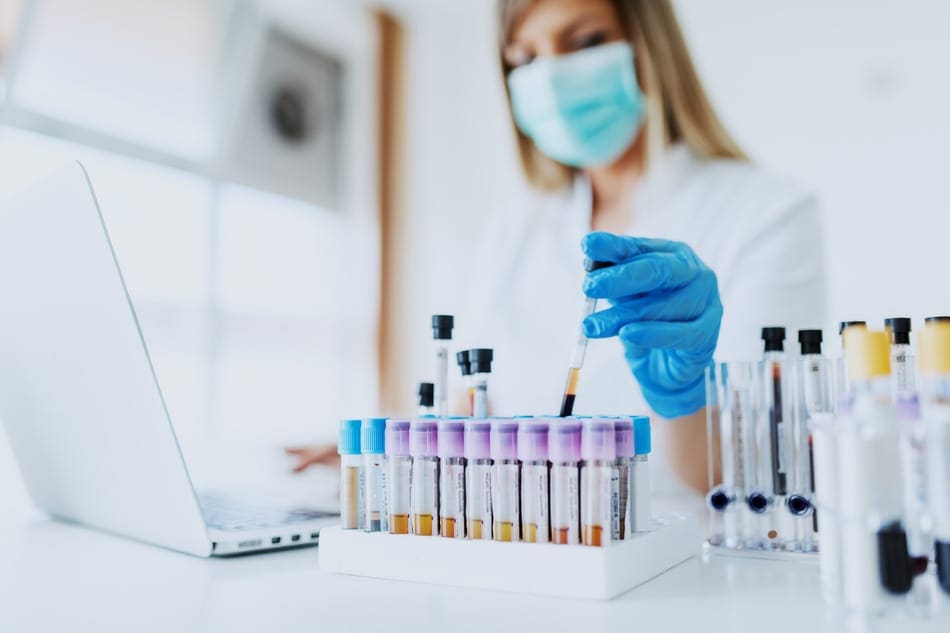Ovarian Cancer Mutations: How Genetic Changes Influence Risk and Treatment
September 4, 2024

At Not These Ovaries, we understand the importance of learning about the genetic factors that contribute to ovarian cancer. We are committed to helping all women understand the role of ovarian cancer mutations, which can significantly influence a person’s risk and treatment options.
What Does It Mean to Have a Gene Mutation?
A genetic mutation (also sometimes called genetic alteration) is a permanent alteration in the DNA sequence that makes up a gene. DNA consists of four nucleotide bases: adenine (A), thymine (T), guanine (G), and cytosine (C). The sequence of these bases determines the genetic information for an organism. A mutation occurs when there is a change in this sequence, such as a substitution, deletion, or insertion of one or more nucleotides.
Mutations can be inherited from parents (germline mutations) or acquired during an individual’s lifetime (somatic mutations). Inherited mutations are present in every cell of the body and can be passed on to future generations. Acquired mutations occur in specific cells and are not passed onto offspring.
While some mutations have no apparent effect on health, others can contribute to the development of diseases, such as cancer. Mutations in tumor suppressor genes, oncogenes, or DNA repair genes can lead to uncontrolled cell growth and tumor formation.
Decoding Ovarian Cancer Mutations: What You Need to Know
Ovarian cancer is a serious and complex disease that affects tens of thousands of women every year. There is a wide range of ovarian cancer risk factors to consider when assessing risk; in particular, genetic mutations play a significant role. By understanding these mutations, you can put yourself in a better position to assess your risk, improve early detection, and explore targeted treatment options.
Germline Mutations and Somatic Mutations
The genetic mutations discussed in this article are primarily germline mutations, meaning they are inherited and can be passed down from parent to child. These mutations can be identified through genetic blood tests or saliva tests.
However, not all genetic mutations associated with ovarian cancer are germline; many are somatic mutations that occur within the tumor cells themselves and are not inherited.
One example of a somatic mutation in ovarian cancer is the RB1 mutation, which is not typically included in the list of inherited mutations. It’s worth noting that some mutations, like TP53, can be either germline or somatic, depending on the individual case.
It’s crucial to understand that even if a woman tests negative for germline mutations, she may still develop ovarian cancer due to somatic mutations, which cannot be detected through standard genetic tests used for assessing hereditary cancer risk.
Somatic mutations: These are genetic changes that occur within the cells of the tumor itself. They are not present in the person’s normal, healthy cells and cannot be passed down to their children.
Somatic mutations are acquired during a person’s lifetime and can be caused by various factors, such as exposure to carcinogens or random errors during cell division. Tumor testing, such as molecular profiling or genomic sequencing, is designed to detect these specific mutations within the tumor cells.
Keep in mind that in most cases, a representative sample of the tumor is tested only once for somatic mutations — unless there are specific reasons to repeat the test (insufficient or low-quality sample or heterogeneity within the tumor).
Germline mutations: These are genetic changes that are inherited from a parent and are present in every cell of the body, including the tumor cells.
Germline mutations can be identified through genetic blood tests or saliva tests, as they are present in all cells of the body, not just the tumor. While tumor testing may incidentally detect germline mutations, it is not the primary purpose of such tests.
The distinction between somatic and germline mutations is important because they have different implications for cancer treatment and hereditary cancer risk assessment. Somatic mutations can help guide targeted therapy decisions and provide information about the tumor’s characteristics.
In contrast, germline mutations can inform a person’s risk of developing certain cancers and may prompt genetic testing for family members to determine their risk as well.
While genetic testing for germline mutations can provide valuable information about a woman’s risk of developing ovarian cancer, it does not provide a complete picture of all possible genetic factors involved in the disease. Both germline and somatic mutations play crucial roles in the development and progression of ovarian cancer, and understanding both types is essential for comprehensive cancer care.
Common Ovarian Cancer Gene Mutations
 Let’s take a closer look at different types of germline mutations associated with ovarian cancer.
Let’s take a closer look at different types of germline mutations associated with ovarian cancer.
BRCA Mutations: A Significant Risk Factor
BRCA1 and BRCA2 are tumor suppressor genes that play a crucial role in repairing double-strand breaks in DNA. When these genes function normally, they help maintain the stability of a cell’s genetic material, preventing the development of certain cancers.
However, when BRCA1 or BRCA2 have harmful mutations, their ability to repair damaged DNA is compromised, leading to an increased risk of ovarian and breast cancer. According to research, women with BRCA1 mutations have a 39-46% lifetime risk of developing ovarian cancer, while those with BRCA2 mutations have a 10-27% risk.
Learn more about BRCA testing for ovarian cancer.
Ovarian Cancer and BRCA Mutations: Practical Advice for Women
Know your family history. If you have a family history of ovarian, breast, or related cancers, talk to your healthcare provider about your risk and whether genetic testing is appropriate for you.
Consider genetic testing. If you are at high risk for BRCA mutations, genetic testing can help you make informed decisions about your health. Our team can provide guidance and support throughout the testing process.
Explore risk-reducing options. If you have a BRCA mutation, there are several options to help reduce your risk of ovarian and breast cancer, including:
- Enhanced screening: For breast cancer, more frequent mammograms and MRIs can help with early detection. However, ovarian cancer screening is trickier. There’s no reliable screening method for women without symptoms. If CA-125 levels are high, doctors typically follow up with a transvaginal ultrasound (TVUS) before considering more invasive procedures. If the TVUS is normal, they’ll explore other potential causes for elevated CA-125 or any symptoms. Remember, these tests aren’t perfect. They can miss cancers or suggest problems that don’t exist. That’s why it’s crucial to know your body and promptly report any persistent changes to your doctor.
- Chemoprevention: Certain medications, such as oral contraceptives, have been shown to reduce the risk of ovarian cancer in women with BRCA mutations.
- Prophylactic surgery: Some women with BRCA mutations may choose to undergo preventive surgeries, such as oophorectomy surgery or a bilateral salpingo-oophorectomy (removal of the ovaries and fallopian tubes) to reduce their risk of ovarian cancer or a bilateral mastectomy (removal of both breasts) to reduce their risk of breast cancer.
Seek support. Learning about a BRCA mutation can be emotionally challenging. Remember that this does not mean you will definitely develop ovarian or breast cancer. However, understanding your risk and exploring risk-reducing options can help you take proactive steps to protect your health.
Here at Not These Ovaries, we are dedicated to supporting women navigating this complex landscape, helping them cope with the implications of their genetic status, and advancing research to improve outcomes for those affected by ovarian cancer.
CHEK2 Mutations
The CHEK2 gene provides instructions for making a protein called checkpoint kinase 2. This protein plays a crucial role in regulating cell division and repairing damaged DNA.
When DNA damage occurs, the CHEK2 protein is activated and helps stop cell division, allowing time for the damage to be repaired. If the damage cannot be repaired, the CHEK2 protein may signal the cell to undergo apoptosis (programmed cell death) to prevent the damaged cell from dividing and potentially becoming cancerous.
Mutations in the CHEK2 gene can disrupt the normal function of the checkpoint kinase 2 protein, leading to an increased risk of several types of cancer, including ovarian cancer. Women with CHEK2 mutations have a 6% lifetime risk of ovarian cancer, compared to 1.3% in the general population.
In addition to ovarian cancer, CHEK2 mutations are also associated with an increased risk of breast cancer. Women with a CHEK2 mutation have a 20-30% lifetime risk of developing breast cancer, compared to about 12% in the general population.
Lynch Syndrome
Lynch syndrome, also known as hereditary nonpolyposis colorectal cancer (HNPCC), is an inherited genetic condition that increases the risk of several types of cancer, including ovarian cancer. Lynch syndrome is caused by inherited mutations in DNA mismatch repair (MMR) genes, primarily MLH1, MSH2, MSH6, and PMS2.
MMR genes play a crucial role in repairing errors that occur during DNA replication. These genes help maintain the integrity of the genetic information by recognizing and correcting mismatched nucleotides. When MMR genes are functioning normally, they prevent the accumulation of mutations that can lead to cancer development.
Individuals with Lynch syndrome have a significantly increased risk of developing certain types of cancer, particularly colorectal cancer and endometrial cancer. They also have an elevated risk of ovarian cancer, as well as other cancers such as stomach, small intestine, liver, gallbladder, upper urinary tract, and brain cancers.
Women with Lynch syndrome have a 6-12% lifetime risk of developing ovarian cancer, compared to about 1.3% in the general population. The risk varies depending on the specific MMR gene mutation:
- MLH1 and MSH2 mutations: 6-12% lifetime risk
- MSH6 mutations: 1-2% lifetime risk
- PMS2 mutations: Unknown, but likely lower than MLH1 and MSH2
Ovarian cancers associated with Lynch syndrome tend to be diagnosed at an earlier age compared to sporadic ovarian cancers. Women with Lynch syndrome may benefit from enhanced surveillance and risk-reducing strategies:
- Surveillance: Regular gynecologic examinations, transvaginal ultrasound, and CA-125 testing may help detect ovarian cancer at an early stage.
- Risk-reducing surgery: Prophylactic ovarian cancer hysterectomy and bilateral salpingo-oophorectomy can significantly reduce the risk of ovarian and endometrial cancer in women with Lynch syndrome.
- Genetic counseling: Individuals with Lynch syndrome should receive genetic counseling to understand their risks, discuss management options, and consider testing for at-risk family members.
BRIP1 Mutations
The BRIP1 (BRCA1 interacting protein C-terminal helicase 1) gene, also known as FANCJ, encodes a protein that belongs to the DEAH helicase family. BRIP1 interacts with BRCA1 and plays a role in DNA repair, particularly in the repair of DNA double-strand breaks and interstrand crosslinks.
Mutations in the BRIP1 gene can impair its function in DNA repair, leading to genomic instability and an increased risk of ovarian cancer. Women with BRIP1 mutations have a 2.6 times higher risk of ovarian cancer than that of the general population.
ATM Mutations
The ATM (ataxia-telangiectasia mutated) gene encodes a protein kinase that plays a critical role in the cellular response to DNA double-strand breaks. The ATM protein is involved in the activation of cell cycle checkpoints, DNA repair, and apoptosis in response to DNA damage.
Mutations in the ATM gene can compromise its function in DNA damage response, leading to an increased risk of various cancers, including ovarian cancer. Women with ATM mutations have a 1.7% lifetime risk of ovarian cancer, which is approximately 2-3 times higher than the general population.
Less Common Ovarian Cancer Gene Mutations
Other gene mutations, such as RAD51C, RAD51D, and PALB2, can increase ovarian cancer risk, though they are less common.
Multiple genetic mutations can increase the risk of ovarian cancer because several genes play crucial roles in maintaining the normal function of ovarian cells. Mutations in these genes can disrupt critical cellular processes, leading to uncontrolled cell growth and tumor formation. Additionally, the combined effect of multiple genetic variants, genetic heterogeneity, and gene-environment interactions can contribute to the complexity of ovarian cancer risk.
Implications of Ovarian Cancer Mutations
Keep in mind that the risk of ovarian cancer is not determined by genetic factors alone. Environmental and lifestyle factors like age, reproductive history, and hormone use can also influence risk. These factors may interact with genetic mutations to modify an individual’s overall risk of developing ovarian cancer.
We recommend considering genetic testing if you have a personal or family history of ovarian, breast, or other related cancers. Genetic testing can help identify if you have any of the above mutations, allowing you to make informed decisions about your health.
Knowing your mutation status can also help guide treatment decisions, as some targeted therapies work better for women with specific mutations. It can also help you take preventive measures, such as increased screening or even preventive surgery.
If you test positive for a mutation, it’s important to share this information with family members, as they may also be at increased risk.
Ovarian Cancer Gene Mutation Testing
There are several types of genetic testing available for women who want to assess their risk of ovarian cancer based on genetic mutations. The choice of test depends on factors such as personal and family history of cancer, ancestry, and specific gene mutations of interest.
- Single gene testing: This type of test looks for mutations in a specific gene known to increase ovarian cancer risk, such as BRCA1, BRCA2, or one of the Lynch syndrome genes (MLH1, MSH2, MSH6, or PMS2). Single-gene testing is typically recommended when there is a known mutation in the family or when an individual’s personal or family history suggests a specific genetic syndrome.
- Multigene panel testing: These tests simultaneously analyze multiple genes associated with ovarian cancer risk. Panel testing is often recommended when there is a strong personal or family history of ovarian or related cancers but no known mutation in the family.
- Comprehensive cancer risk panels: These panels test for genes associated with inherited cancer syndromes, including ovarian cancer. They may include genes related to breast, colorectal, endometrial, pancreatic, and other cancers in addition to ovarian cancer genes. Comprehensive panels are considered when an individual’s personal or family history suggests multiple cancer risks.
- Population-based genetic testing: In some cases, population-based genetic testing may be recommended for certain groups with a higher prevalence of specific mutations.
- Tumor testing: Tumor testing primarily identifies somatic mutations, not germline mutations. Testing can be performed on a tumor sample to help guide treatment decisions or provide information about the likelihood of an inherited cancer predisposition syndrome.
Genetic testing is a personal decision that should be made in consultation with a healthcare provider or genetic counselor. They can help interpret your individual personal and family history, assess the appropriateness of genetic testing, and explain your results’ potential benefits, limitations, and implications.
Genetic testing can provide valuable information about ovarian cancer risk, but it is not perfect. Some women with mutations may never develop ovarian cancer, while others without identified mutations may still develop the disease. It’s important to note that even without ANY genetic mutations or known lifestyle risk factors, ovarian cancer can still occur.
If it does, and you never had any risk factors or genetic predispositions, it’s not your fault. This means that testing should be combined with other risk assessment tools, such as family history and lifestyle factors, to guide individualized prevention and management strategies. However, the absence of known risk factors does not eliminate the possibility of developing ovarian cancer.
Not These Ovaries is dedicated to advancing the understanding of ovarian cancer mutations through research and trials. Our goal is to improve outcomes for women with ovarian cancer, particularly the rarer types like borderline and low-grade serous ovarian cancer.
If you’re concerned about your ovarian cancer risk, we encourage you to talk to your healthcare provider about genetic testing and ways to manage your risk. Our team is here to support you and provide the expertise you need to make informed decisions about your health. Together, we can work towards a future where more women survive and thrive after an ovarian cancer diagnosis.


